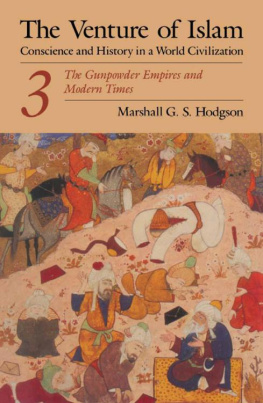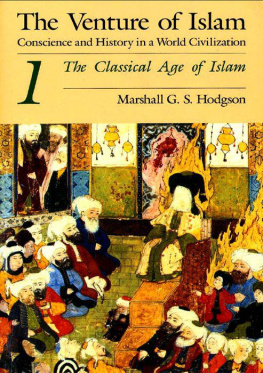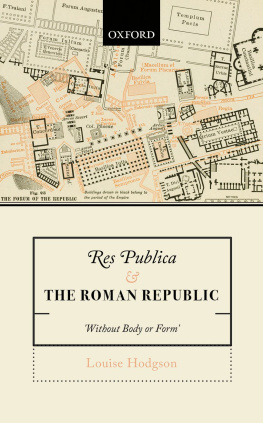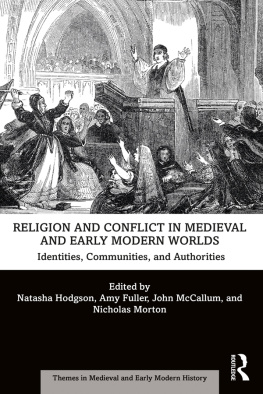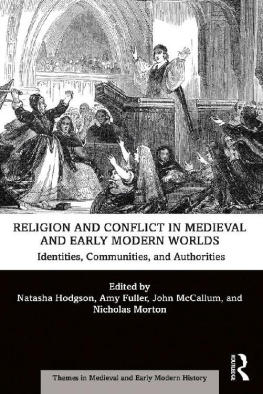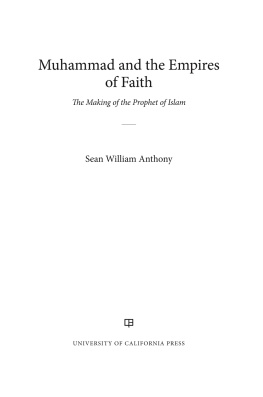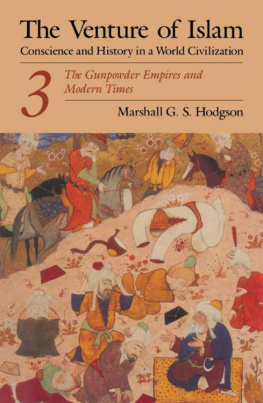Hodgson - The Venture of Islam, Volume 3: The Gunpower Empires and Modern Times
Here you can read online Hodgson - The Venture of Islam, Volume 3: The Gunpower Empires and Modern Times full text of the book (entire story) in english for free. Download pdf and epub, get meaning, cover and reviews about this ebook. year: 2009, publisher: University of Chicago Press, genre: Religion. Description of the work, (preface) as well as reviews are available. Best literature library LitArk.com created for fans of good reading and offers a wide selection of genres:
Romance novel
Science fiction
Adventure
Detective
Science
History
Home and family
Prose
Art
Politics
Computer
Non-fiction
Religion
Business
Children
Humor
Choose a favorite category and find really read worthwhile books. Enjoy immersion in the world of imagination, feel the emotions of the characters or learn something new for yourself, make an fascinating discovery.
- Book:The Venture of Islam, Volume 3: The Gunpower Empires and Modern Times
- Author:
- Publisher:University of Chicago Press
- Genre:
- Year:2009
- Rating:3 / 5
- Favourites:Add to favourites
- Your mark:
- 60
- 1
- 2
- 3
- 4
- 5
The Venture of Islam, Volume 3: The Gunpower Empires and Modern Times: summary, description and annotation
We offer to read an annotation, description, summary or preface (depends on what the author of the book "The Venture of Islam, Volume 3: The Gunpower Empires and Modern Times" wrote himself). If you haven't found the necessary information about the book — write in the comments, we will try to find it.
The Venture of Islam, Volume 3: The Gunpower Empires and Modern Times — read online for free the complete book (whole text) full work
Below is the text of the book, divided by pages. System saving the place of the last page read, allows you to conveniently read the book "The Venture of Islam, Volume 3: The Gunpower Empires and Modern Times" online for free, without having to search again every time where you left off. Put a bookmark, and you can go to the page where you finished reading at any time.
Font size:
Interval:
Bookmark:
in a World Civilization
VOLUME THREE
THE GUNPOWDER EMPIRES
AND MODERN TIMES
MARSHALL G. S. HODGSON
THE UNIVERSITY OF CHICAGO PRESS
CHICAGO AND LONDON
To John U. Nef
and to the memory of
Gustave E. von Grunebaum
in admiration and gratitude
Some of the material in these volumes has been issued in a different form in Introduction to Islamic Civilization (volumes 1, 2, 3. Copyright 1958, 1959 by The University of Chicago), in A History of Islamic Civilization (Copyright 1958 by Marshall G. S. Hodgson), and in an earlier version of The Venture of Islam (volumes 1, 2. Copyright 1961 by Marshall G. S. Hodgson).
The University of Chicago Press, Chicago 60637
The University of Chicago Press. Ltd., London
1974 by The University of Chicago
All rights reserved. Published 1974
Paperback edition 1977
Printed in the United States of America
ISBN: Vol. 1. 0-226-34683-8 (paper);
Vol. 2. 0-226-34684-6 (paper);
Vol. 3. 0-226-34685-4 (paper)
ISBN: 978-0-226-34688-5 (electronic)
LCN: 73-87243
03 02 01 00 11 12 13
 The paper used in this publication meets the minimum requirements of the American National Standard for Information SciencesPermanance of Paper for Printed Library Materials, ANSI Z39.48-1992.
The paper used in this publication meets the minimum requirements of the American National Standard for Information SciencesPermanance of Paper for Printed Library Materials, ANSI Z39.48-1992.
VOLUME III
VOLUME III
VOLUME III
The end of everything should direct the means: now that of government being the good of the whole, nothing less should be the aim of the prince.
Wm. Penn
The three centuries after about 1500 CE are most obviously important for us because they form the immediate background of our own age. The Islamdom that entered into Modern times was that which took shape in these centuries. Moreover, that Islamdom was not just one society among several non-Western civilizations. It was the one society that had come the closest to playing the world-dominating role which (as it turned out) the West was actually to play. If one includes the Christian and Hindu and Buddhist peoples then ruled by Muslims or enclaved by them, it is the society that lies back of the bulk of the present Islamo-Asian developing sector of the world. Apart from China and its neighbours, Islam looms more or less large in the background of most of the present low-investment areas of the Eastern Hemisphere; and it is the Islamdom of just these recent centuries which, historically, has been most relevant to their present posture.
But these centuries are important also, in a less accidental way, as increasing our understanding of the potentialities and limitations of the Islamicate civilization as it had developed during the Middle Periods. The successful synthesis of the Earlier Middle Period, in which the Shar' conscience, together with  fism, seemed to have worked out a social pattern that met the most essential conditions for an ongoing (and very expansive) social life, had led on by its very success to a triumph of the conservative spirit. Though its inner contradictions had also opened the way to diverse disruptive tendencies of the Later Middle Period, the conservative spirit was not substantially again put in question. That spirit became the setting within which Muslim individuals had to labour, and the Muslim conscience had to find expression.
fism, seemed to have worked out a social pattern that met the most essential conditions for an ongoing (and very expansive) social life, had led on by its very success to a triumph of the conservative spirit. Though its inner contradictions had also opened the way to diverse disruptive tendencies of the Later Middle Period, the conservative spirit was not substantially again put in question. That spirit became the setting within which Muslim individuals had to labour, and the Muslim conscience had to find expression.
Meanwhile, the pattern of society and culture that had been formed after the fall of the High Caliphal state came to some crucial impasses by the age of Mongol prestige. As earlier frameworks for cultural creativity were filled in, the conservative spirit itself seemed to be imposing limitations on any possible new creativity; in the arts and even in scholarly inquiry, one could fear that Muslims were becoming trapped in a style cycle if not in ideological stultification by the Shar' spirit. Even more serious could appear the inability of Muslims to form enduringly legitimate governments. True legitimacy was confined to the Shar'ah, which had come to be associated with an almost apolitical social order, to which, as well as to the Shar'ah itself, the political heads and their garrisons were almost an alien intrusion. The problem of establishing legitimate government was presumably compounded by the basic economic problem of wastage of resources especially in the Arid Zone.
To these impasses the new age found answers without essentially breaching the conservative spirit. The answers carried their own dilemmas, but meanwhile, one of the greatest periods of human achievement blossomed out of the midst of the conservative spirit. At the start of the sixteenth century, a general realignment of political forces among all the Muslim peoples afforded an opportunity for extensive political and then cultural renewal. It had major cultural consequences almost everywhere, which largely determined the history of the two or three centuries following. Some of the most important long-run tendencies in Islamicate society were reversed. There was a brilliant renewal of political and cultural life. From the viewpoint of those who looked to absolutist government and the high culture that went with it, Islamdom could seem finally to have come into its own.
But in the light of a more specifically Islamic conscience, the renewal failed. For on a different level of consideration, the conservative spirit posed a deeper problem, not so readily solved. Governments might forge for themselves a civic legitimacy which gave them durability. The culture of the wealthy might find ways to flourish despite apparently coming to the end of the road. But the Islamic ideals did not necessarily find their fulfillment therein. It was, indeed, in part the continuing pressure of the Islamic vision that produced the new dilemmas to which the new answers were to lead. If the Islamic ideals were to be fulfilled, a more basic renewal was required. This was indeed felt passionately, if unhistorically, by the many would-be reformers as well as by those, more pessimistic, who acquiesced in the status quo.
On conscience and tradition
The beginning of the period stands out clearly for us. The realignments of gunpowder times (at the start of the sixteenth century) introduced two interdependent reversals of historic trends: one negative and one positive. In 1500, Islamdom was expanding over the hemisphere as a relatively integral cultural and political order. Despite considerable diversity of language, custom, artistic tradition, and even religious practice, the unity of the Dr al-Islm was a more significant fact politically than the existence of any of the states within it, which were of a local and in many cases a transient character. By 1550, a major blow had been dealt to the cosmopolitan comprehensiveness of Islam. Even on the religious level, the Muslims were divided by a newly embittered religious quarrel between Sh's and Jama'-Sunns. More important, great regional empires were going far to forge their separate cultural worlds, partitioning among themselves all of what may be called by this time the central zone of Islamdomthe whole zone from the Balkans to Bengal. Outside these regional empires, in the Southern Seas and in the Volga basin, Muslims found themselves more threatened by infidels than at any time since the Mongol conquests, and looking to the new empires of the more central zone for support.
But on the positive side, the weakening of the apolitical cosmopolitan unity was compensated by a partial solution to the problem of governmental legitimacy. The empires which, by 1550, were dividing up the greater part of Islamdom, heirs to the ideals of the military patronage state, were able to assert a considerable measure of political legitimacy within their own spheres. If it was under the primacy of the market-place culture that the international Islamicate cosmopolitanism had developed, it was largely under courtly auspices that the several regions asserted their relative cultural autonomy. The very fact that these empires were taking a major part in forming the social and cultural life of Islamdom within their domains allowed new forms of integration to be attempted within each of them. At least within their boundaries, a certain rapprochement took place between government, the representatives of the Shar'ah law, and popular Muslim institutions. Whatever reduction in economic resources may have supervened in the mid-Arid Zone in the preceding centuries was compensated, on the level of Islamicate high-cultural life generally, by the spread of the society, of the area in which Muslim activity could be initiated and patrons found.
Font size:
Interval:
Bookmark:
Similar books «The Venture of Islam, Volume 3: The Gunpower Empires and Modern Times»
Look at similar books to The Venture of Islam, Volume 3: The Gunpower Empires and Modern Times. We have selected literature similar in name and meaning in the hope of providing readers with more options to find new, interesting, not yet read works.
Discussion, reviews of the book The Venture of Islam, Volume 3: The Gunpower Empires and Modern Times and just readers' own opinions. Leave your comments, write what you think about the work, its meaning or the main characters. Specify what exactly you liked and what you didn't like, and why you think so.

